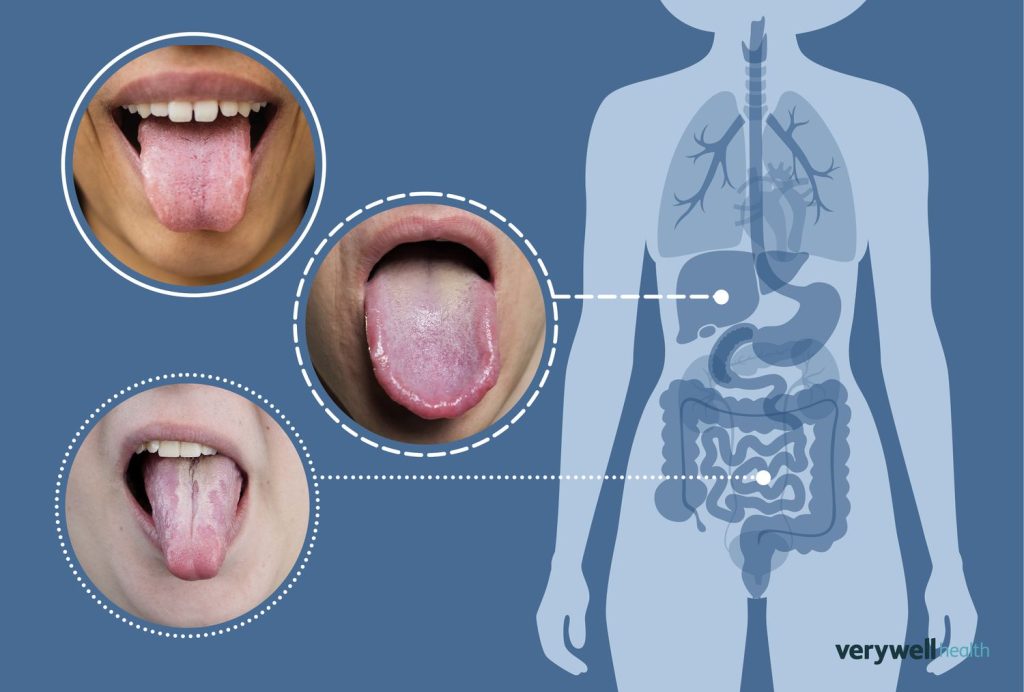Did you know your tongue can reveal important insights about your overall health? From changes in color and texture to unusual bumps, your tongue’s appearance may signal underlying health issues that need attention. Here’s a guide to understanding what your tongue might be trying to tell you.

1. White Coating
A thin white coating on the tongue is normal, but a thick, white, or patchy coating may suggest an imbalance. This can be linked to:
- Oral Thrush: Caused by a yeast overgrowth, oral thrush is common in those with weakened immune systems.
- Dehydration: Lack of hydration can lead to a dry, coated tongue. Be sure to drink plenty of water!
- Poor Gut Health: White patches might indicate an imbalance in gut bacteria, so consider adding more fiber or probiotics to your diet.
2. Bright Red Tongue
A bright red or strawberry-colored tongue can signal several deficiencies:
- Vitamin Deficiencies: A red tongue could mean low levels of B12, folic acid, or iron.
- Scarlet Fever: In some cases, scarlet fever causes a “strawberry tongue.” If it’s accompanied by a high fever, contact your healthcare provider.
- Kawasaki Disease: This condition, more common in children, causes redness and swelling on the tongue. If your child has a bright red tongue along with a rash, seek medical attention.
3. Yellow Tongue
While not as common, a yellowish tint may be a warning sign for:
- Poor Oral Hygiene: Yellow tongue is often linked to poor dental care and can be managed with regular brushing and tongue scraping.
- Liver or Stomach Issues: A yellow tongue may indicate issues with the liver or digestive system. If it persists, consider consulting a healthcare professional.
4. Black Hairy Tongue
This alarming appearance is usually harmless and often temporary:
- Bacterial or Fungal Overgrowth: Black hairy tongue occurs when papillae (tiny bumps on the tongue) grow longer, trapping bacteria.
- Smoking or Poor Oral Hygiene: Often seen in smokers, it’s also associated with poor dental hygiene. Proper brushing, tongue scraping, and quitting smoking can help.
5. Sores or Bumps
Occasional sores or bumps are usually harmless, but watch for patterns:
- Canker Sores: Small, painful ulcers often caused by stress, acidic foods, or injuries.
- Herpes Simplex Virus: Cold sores on the tongue can be caused by HSV and are typically accompanied by other symptoms like tingling or itching.
- Oral Cancer: Persistent sores, bumps, or changes in tongue appearance can be a warning sign. If a sore doesn’t heal in two weeks, get it checked out.
6. Cracks or Fissures
Cracks can be common with age, but deep fissures may indicate:
- Geographic Tongue: Irregular patterns on the tongue that appear and disappear, often harmless but sensitive to certain foods.
- Vitamin Deficiencies: Cracks can signal deficiencies in B vitamins and iron.
7. Smooth, Pale Tongue
If your tongue appears smoother or paler than usual, it may be due to:
- Anemia: A smooth, pale tongue may indicate low iron levels. Anemia can also lead to fatigue and weakness.
- Nutritional Deficiencies: A lack of nutrients, particularly B vitamins, can cause smoothness and a glossy texture.
How to Keep Your Tongue Healthy
- Practice Good Oral Hygiene: Brush your teeth and tongue daily, and use mouthwash to maintain a clean mouth.
- Stay Hydrated: Water helps flush out toxins and prevent dryness or coating.
- Eat a Balanced Diet: Ensure you’re getting a variety of vitamins and minerals to support your overall health.
- Monitor Changes: Pay attention to persistent changes in your tongue and consult a healthcare provider if you notice unusual patterns.
Your tongue is an indicator of more than just oral health—it’s a window to what’s going on in your body. A quick glance can give you clues about hydration, nutritional status, and even immune health, helping you stay proactive about your well-being.

This article is ready to captivate Pinterest users and guide them in understanding what their tongue reveals about their health!



